Cross-Sectional Anatomy and Computed Tomography of the Coelomic Cavity in Juvenile Atlantic Puffins (Aves, Alcidae, Fratercula arctica)
Abstract
:Simple Summary
Abstract
1. Introduction
2. Materials and Methods
2.1. Animals
2.2. CT Technique
2.3. Anatomical Sections
2.4. Anatomic Identification
3. Results
3.1. Anatomical Dissections and Cross-Sections
3.2. Computed Tomography Images
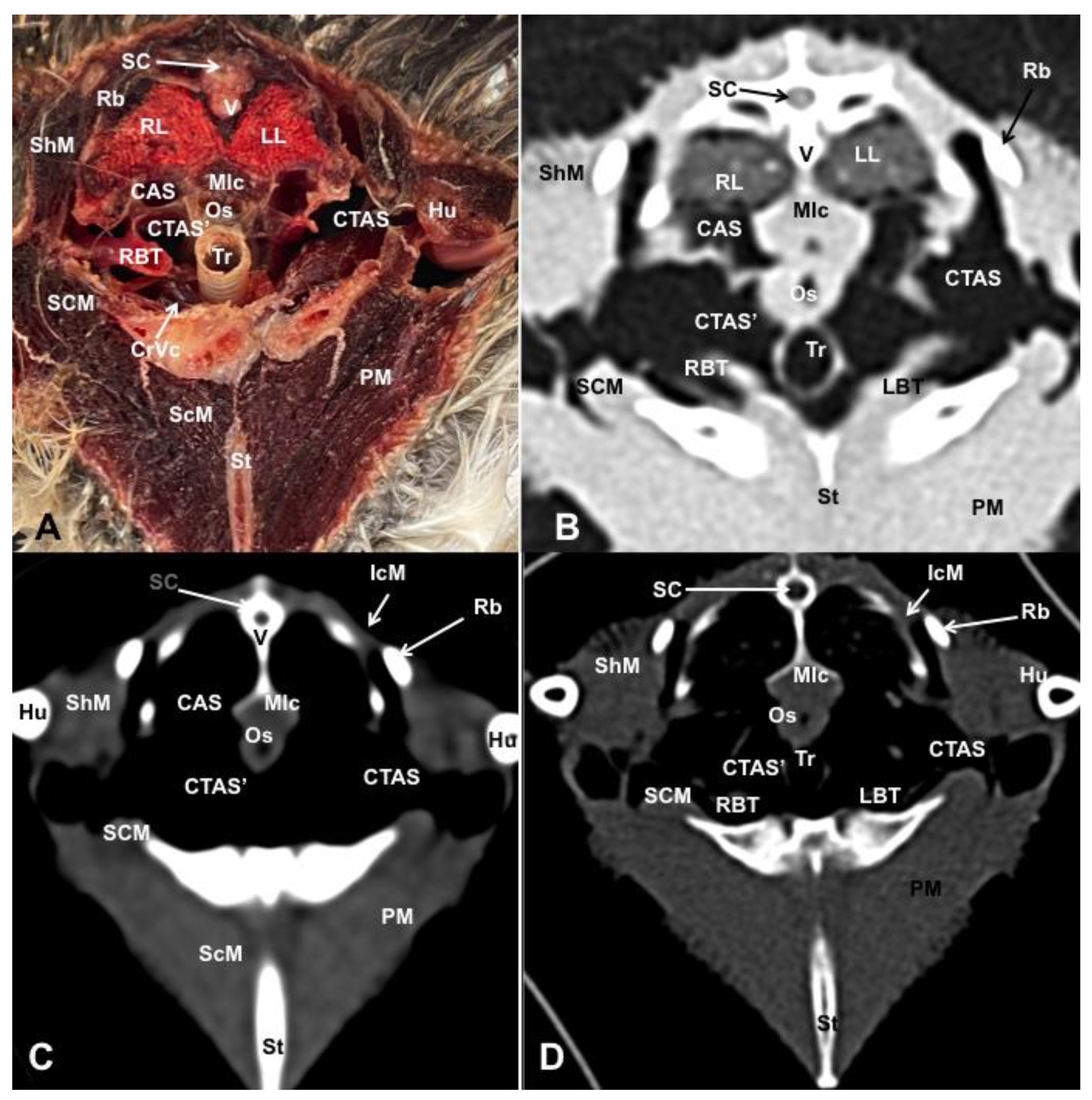

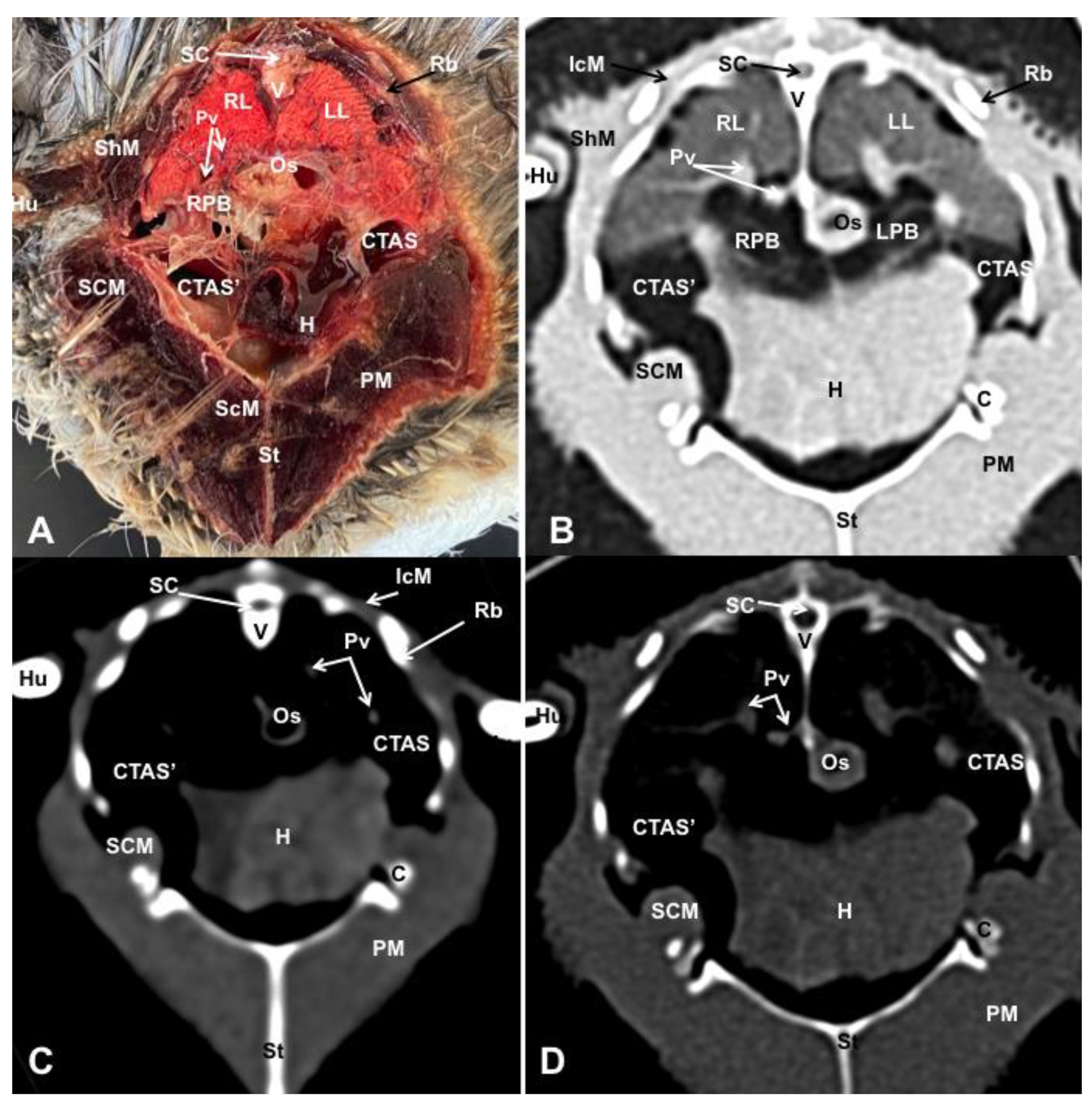
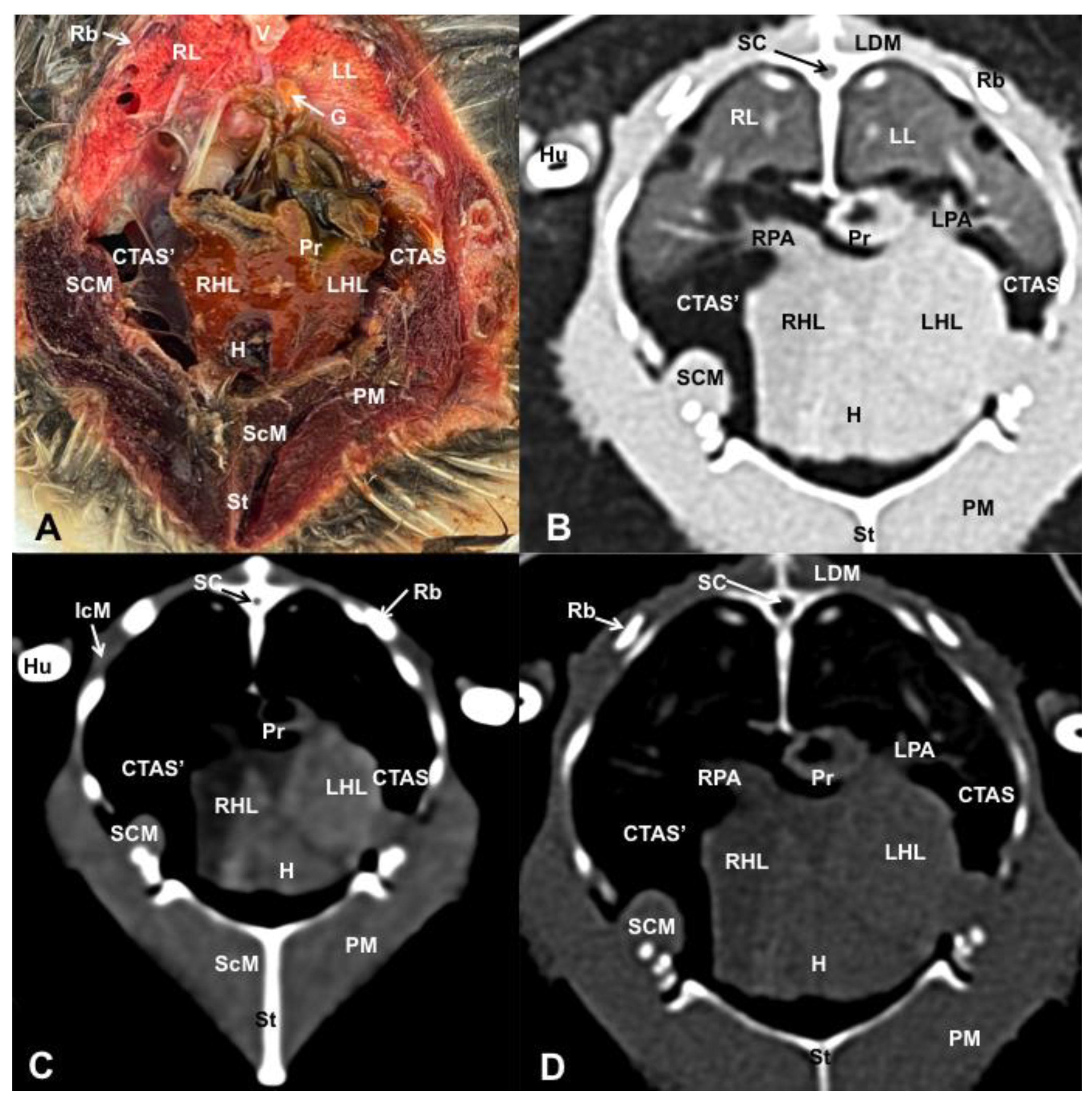
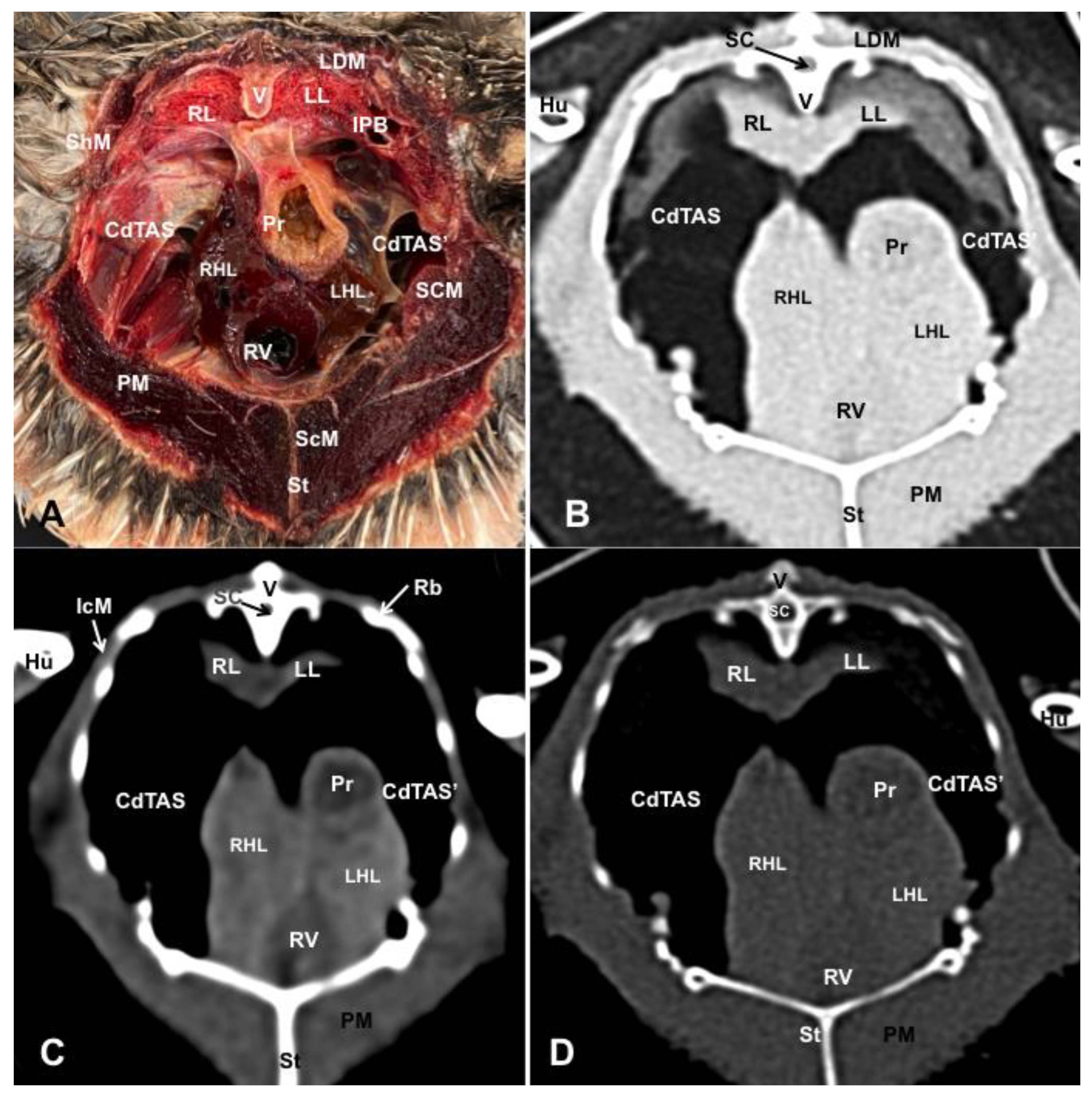
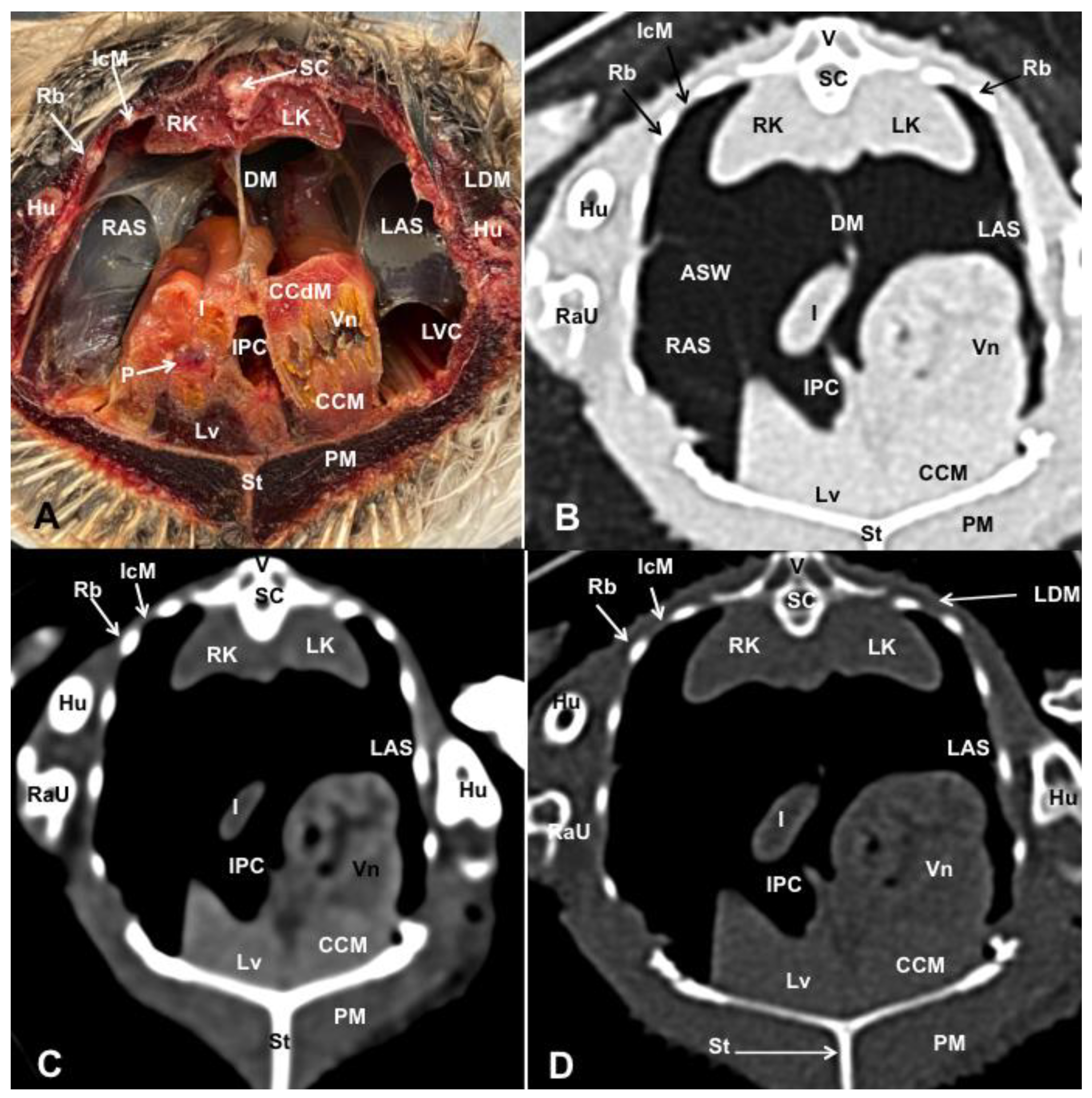
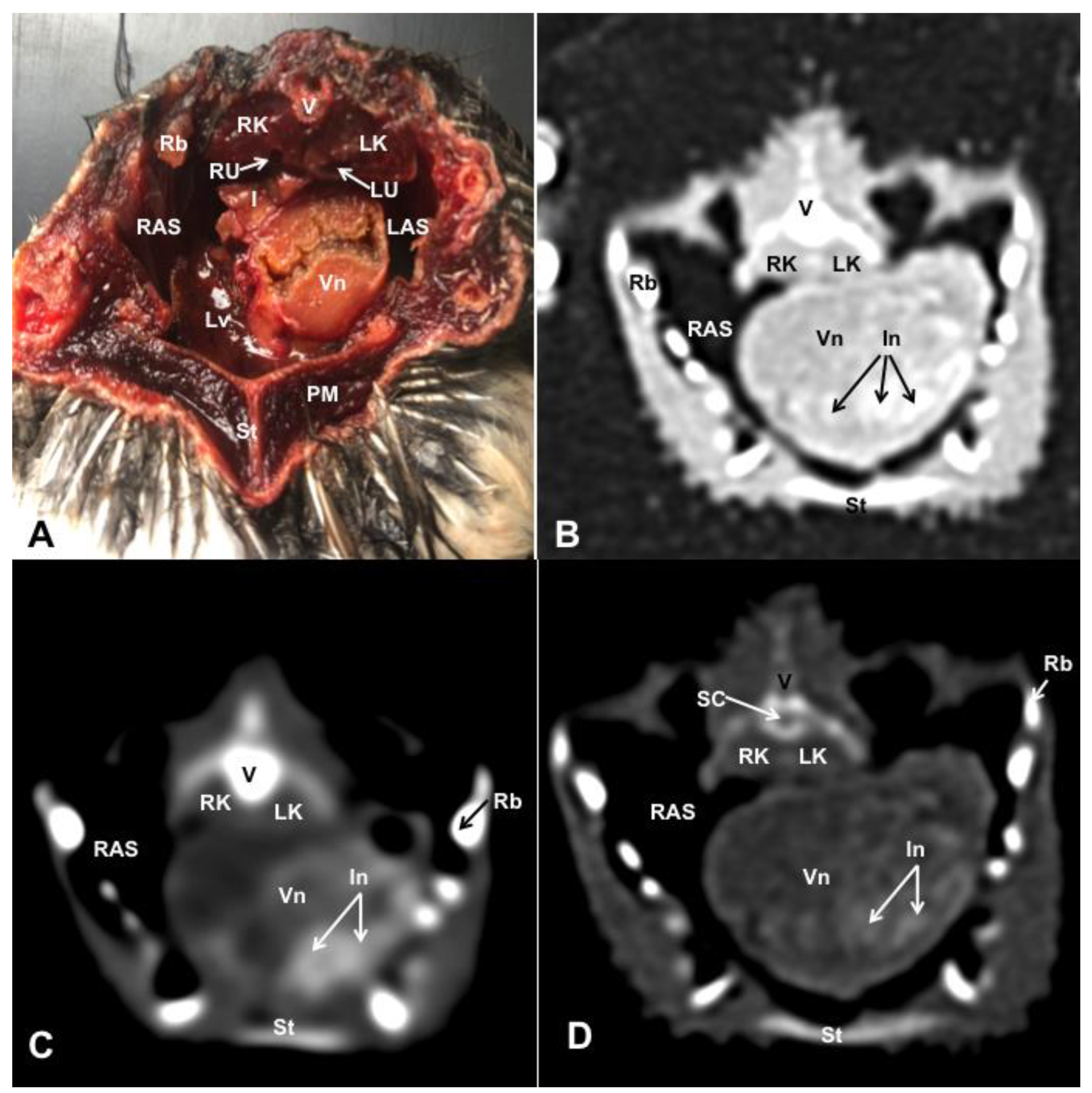
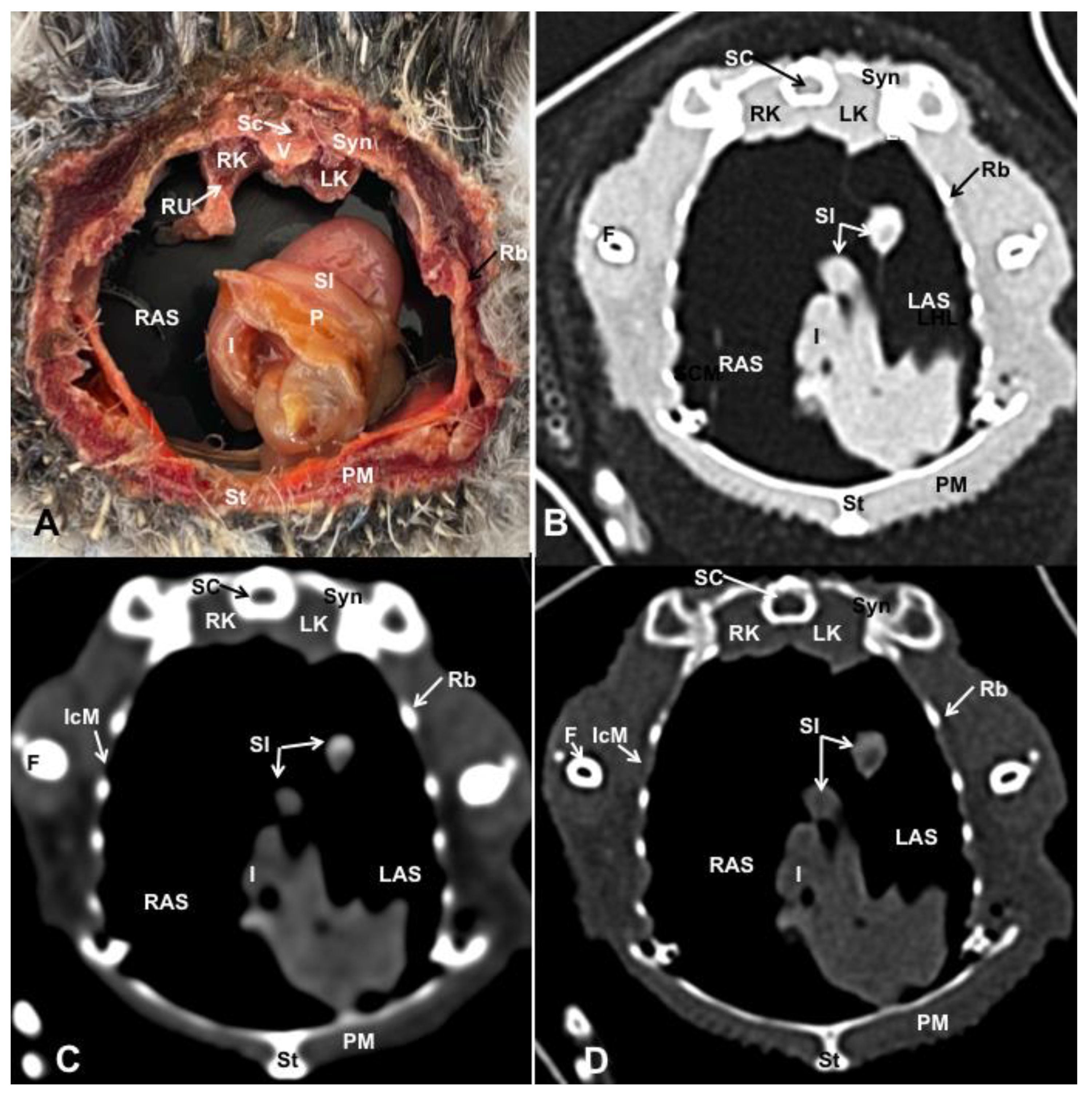
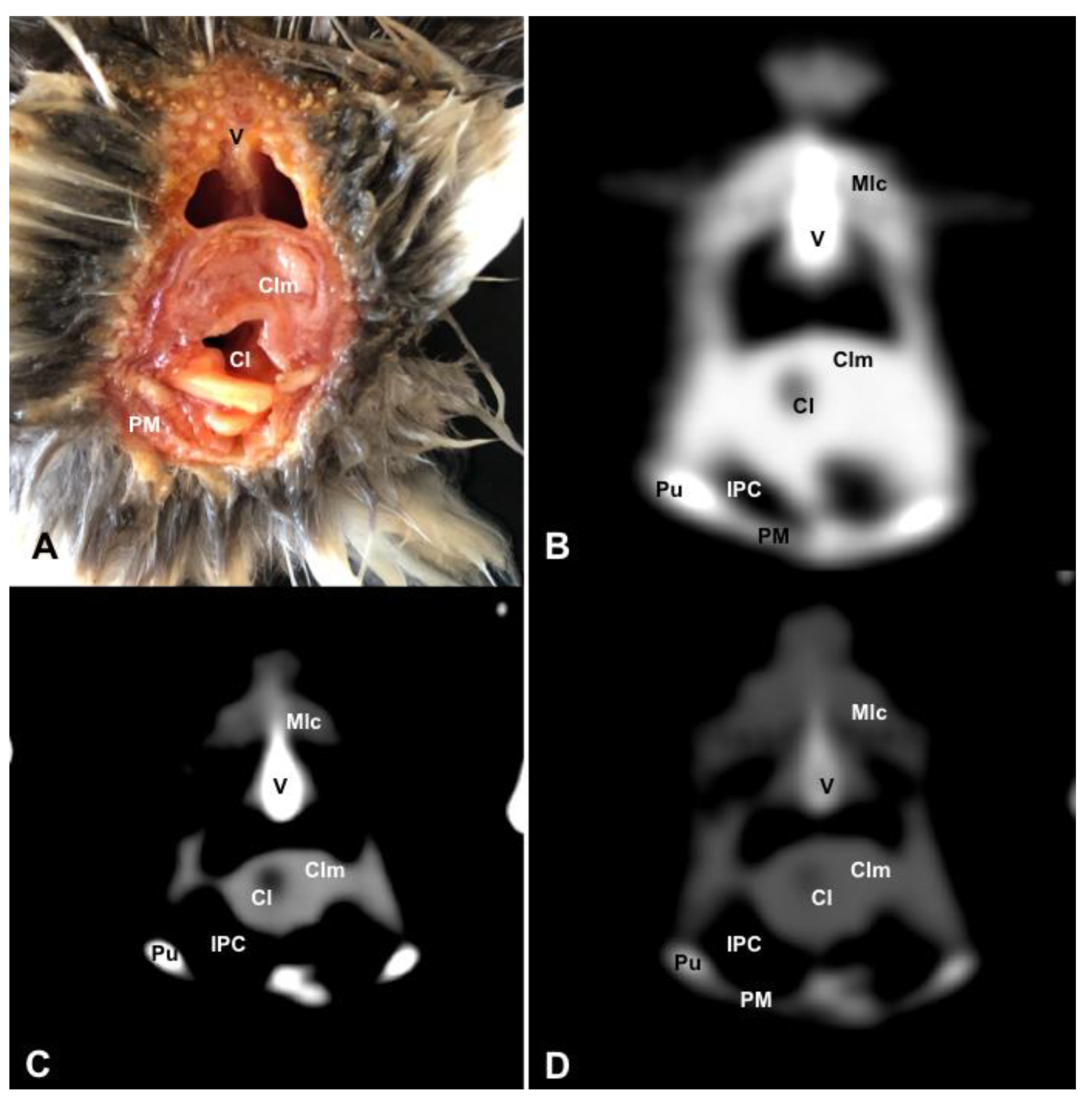
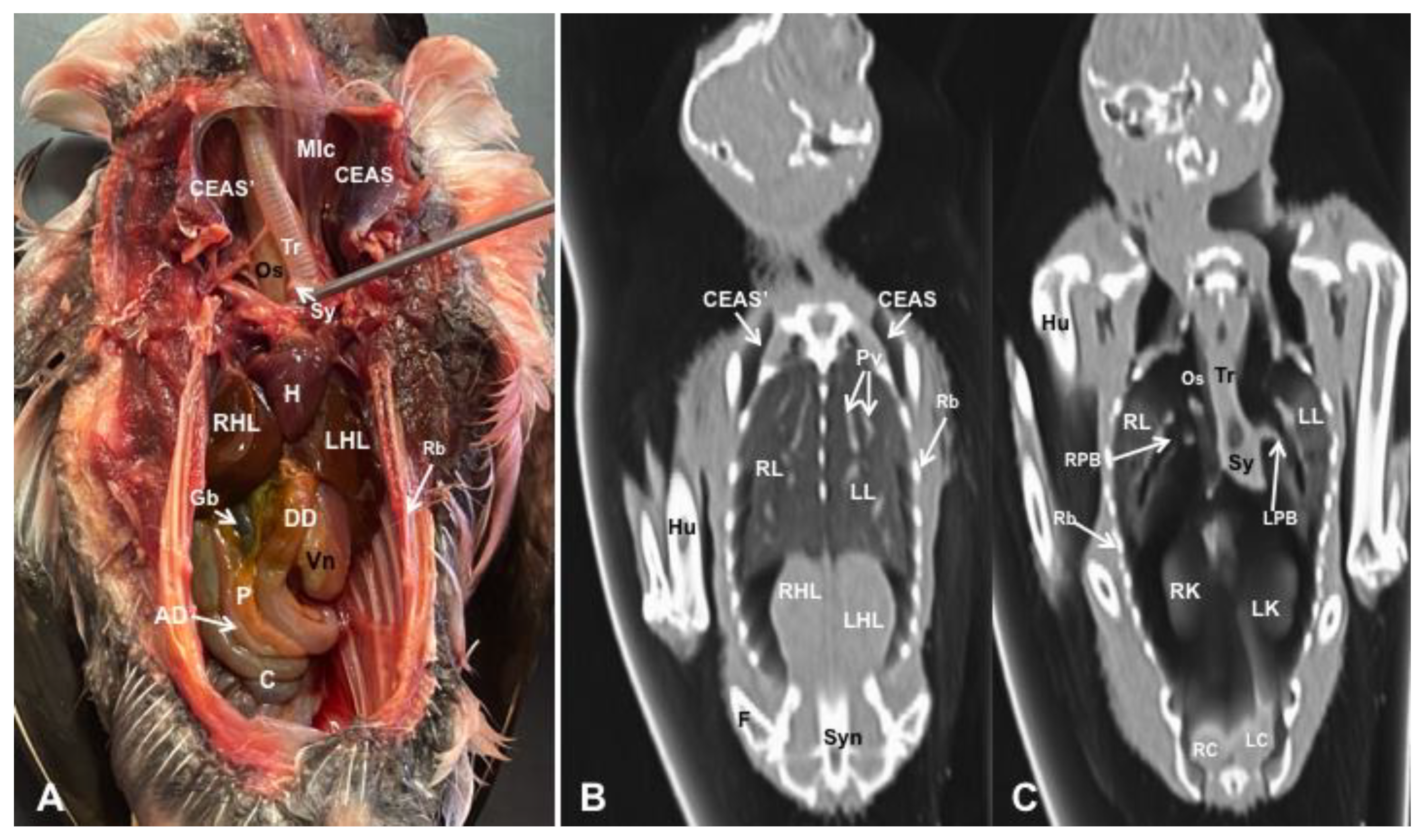
4. Discussion
5. Conclusions
Author Contributions
Funding
Institutional Review Board Statement
Informed Consent Statement
Data Availability Statement
Acknowledgments
Conflicts of Interest
References
- Barrowclough, G.F.; Cracraft, J.; Klicka, J.; Zink, R.M. How Many Kinds of Birds Are There and Why Does It Matter? PLoS ONE 2016, 11, e0166307. [Google Scholar] [CrossRef] [PubMed]
- American Veterinary Medical Association. Available online: https://www.avma.org/resources-tools/reports-statistics/us-pet-ownership-statistis (accessed on 1 June 2023).
- Raftery, A. BSAVA Manual of Psittacine Birds, 2nd ed.; British Small Animal Veterinary Association: Gloucester, UK, 2005; pp. 35–49. [Google Scholar]
- Krautwald-Junghanns, M.E.; Pees, M.; Reese, S.; Tully, T. Diagnostic Imaging of Exotic Pets, 1st ed.; Schlütersche: Hannover, Germany, 2011. [Google Scholar]
- McMillan, M.C. Imaging Techniques; Wingers Publishing: Lake Worth, FL, USA, 1994; pp. 246–326. [Google Scholar]
- Zeeland, Y.R.A.; Schoemaker, N.J.; Hsu, E.W. Current Therapy in Avian Medicine and Surgery; Elsevier: St. Louis, MO, USA, 2016; pp. 531–549. [Google Scholar]
- Haacke, E.M.; Brown, R.W.; Thompson, M.R.; Vankatesan, R. Magnetic Resonance Imaging; John Wiley & Sons: New York, NY, USA, 1999; pp. 331–380, 669–702. [Google Scholar]
- Beuf, O.; Jaillon, F.; Saint-Jalmes, H. Small-animal MRI: Signal-to-noise ratio comparison at 7 and 15 T with multiple-animal acquisition strategies. Magn. Reson. Mater. Phys. 2006, 19, 202–208. [Google Scholar] [CrossRef] [PubMed]
- Lauridsen, H.; Hansen, K.; Wang, T.; Agger, P.; Andersen, J.L.; Knudsen, P.S.; Rasmussen, A.S.; Uhrenholt, L.; Pedersen, M. Inside Out: Modern Imaging Techniques to Reveal Animal Anatomy. PLoS ONE 2011, 6, e17879. [Google Scholar] [CrossRef] [PubMed]
- Dinley, J.; Hawkins, L.; Paterson, G.; Ball, A.D.; Sinclair, I.; Sinnett-Jones, P.; Lanham, S. Micro-computed X-ray tomography: A new non-destructive method of assessing sectional, fly-through and 3D imaging of a soft-bodied marine worm. J. Microsc. 2010, 238, 123–133. [Google Scholar] [CrossRef] [PubMed]
- Ziegler, A.; Faber, A.; Mueller, S.; Bartolomaeus, T. Systematic comparison and reconstruction of sea urchin (Echinoidea) internal anatomy: A novel approach using magnetic resonance imaging. BMC Biol. 2008, 6, 33. [Google Scholar] [CrossRef]
- Rieppel, O.; Gauthier, J.; Maisano, J. Comparative morphology of the dermal palate in squamate reptiles, with comments on phylogenetic implications. Zool. J. Linn. Soc. 2008, 152, 131–152. [Google Scholar] [CrossRef]
- Digital Fish Library. A Collaborative Project at the University of California, San Diego Funded by the National Science Foundation’s (NSF) Biological Infrastructure Program. Available online: www.digitalfishlibrary.org (accessed on 8 June 2023).
- Webb, E.; Yuan, M.; Lemoine, N.; Wang, Y. Imaging in animal models. Integr. Cancer Sci. Ther. 2016, 3, 428–431. [Google Scholar] [CrossRef]
- Schambach, S.J.; Bag, S.; Schilling, L.; Groden, C.; Brockmann, M.A. Application of micro-CT in small animal imaging. Methods 2010, 50, 2–13. [Google Scholar] [CrossRef]
- Farrag, M.; Pukale, D.D.; Leipzig, N.D. Micro-computed tomography utility for estimation of intraparenchymal spinal cord cystic lesions in small animals. Neural Regen. Res. 2021, 16, 2293–2298. [Google Scholar]
- Delk, K.W.; Mejia-Fava, J.; Jiménez, D.A.; Kent, M.; Myrna, K.; Mayer, J.; Divers, S. Diagnostic imaging of peripheral vestibular disease in a Chinese goose (Anser cygnoides). J. Avian Med. Surg. 2014, 28, 31–37. [Google Scholar] [CrossRef]
- Fleming, G.J.; Lester, N.V.; Stevenson, R.; Silver, X.S. High field strength (4.7 T) magnetic resonance imaging of hydrocephalus in an African Grey parrot (Psittacus erithacus). Vet. Radiol. Ultrasound 2003, 44, 542–545. [Google Scholar] [CrossRef] [PubMed]
- Jirak, D.; Janacek, J.; Kear, B.P. A combined MR and CT study for precise quantitative analysis of the avian brain. Sci. Rep. 2015, 5, 16002. [Google Scholar] [CrossRef] [PubMed]
- Romagnano, A.; Shiroma, J.T.; Heard, D.J.; Johnson, R.D.; Schiering, M.R.; Mladinich, M.S. Magnetic resonance imaging of the brain and coelomic cavity of the domestic pigeon (Columba livia domestica). Vet. Radiol. Ultrasound 1996, 37, 431–440. [Google Scholar] [CrossRef]
- Fumero-Hernández, M.; Encinoso, M.; Ramírez, A.S.; Morales, I.; Suárez Pérez, A.; Jaber, J.R. A Cadaveric Study Using Computed Tomography for Measuring the Ocular Bulb and Scleral Skeleton of the Atlantic Puffin (Aves, Alcidae, Fratercula arctica). Animals 2023, 13, 2418. [Google Scholar] [CrossRef] [PubMed]
- Hall, M.I. The anatomical relationships between the avian eye, orbit and sclerotic ring: Implications for inferring activity patterns in extinct birds. J. Anat. 2008, 212, 781–794. [Google Scholar] [CrossRef]
- Andrade, S.B.D.; Araujo, N.L.L.C.D.; Raposo, A.C.S.; Muramoto, C.; Oriá, A.P. Morphometric descriptive report of scleral ossicle rings, by ultrasound and computed tomography, in three Testudines specimens. Ciênc. Rural. 2023, 53, e20210423. [Google Scholar] [CrossRef]
- Orosz, S.E.; Toal, R.L. Tomographic anatomy of the golden eagle (Aquila chrysaetos). J. Zoo Wildl. Med. 1992, 23, 39–46. [Google Scholar]
- Veladiano, I.A.; Banzato, T.; Bellini, L.; Montani, A.; Catania, S.; Zotti, A. Normal computed tomographic features and reference values for the coelomic cavity in pet parrots. BMC Vet. Res. 2016, 12, 182. [Google Scholar] [CrossRef]
- Da Silva, J.P.; Rahal, S.C.; Castiglioni, M.C.R.; Baldissera Gonçalves, R.A.; Doiche, D.P.; Moresco, A.; Mamprim, M.J.; Vulcano, L.C. Radiography and computed tomography of the heart and lower respiratory tract in toco toucans (Ramphastos toco). Anat. Histol. Embryol. 2020, 49, 541–549. [Google Scholar] [CrossRef]
- Pepperberg, I.M.; Howell, K.S.; Banta, P.A.; Patterson, D.K.; Meisser, M. Measurement of grey parrot (Psittacus erithacus) trachea via magnetic resonance imaging, dissection, and electron beam computed tomography. J. Morphol. 1998, 238, 81–91. [Google Scholar] [CrossRef]
- IUCN. The IUCN Red List of Threatened Species. Version 2022-2. Available online: https://www.iucnredlist.org (accessed on 2 June 2023).
- Painter, J. Fratercula arctica. Available online: https://animaldiversity.org/accounts/Fratercula_arctica/ (accessed on 30 May 2023).
- Sisson, S.; Getty, R.; Grossman, J.D. Anatomía de los Animales Domésticos, 5th ed.; Elsevier Masson: Issy les Moulineaux, France, 1982. [Google Scholar]
- MacLelland, J. Atlas en Color de Anatomía de las Aves; McGraw-Hill Interamericana: Madrid, Spain, 1992. [Google Scholar]
- König, E.H.; Liebich, H.G.; Bragulla, H. Anatomie und Propädeutik des Geflügels; Schattauer: Stuttgart, Germany, 2001. [Google Scholar]
- Isaac, I.; Richardson, J.; Liuti, T.; Longo, M. Safety of intravenous iodinated contrast medium injection in rabbits undergoing conscious computed tomography. Vet. Rec. Open 2022, 9, e31. [Google Scholar] [CrossRef] [PubMed]
- Seamon, A.B.; Hofmeister, E.H.; Divers, S.J. Outcome following inhalation anesthesia in birds at a veterinary referral hospital: 352 cases (2004–2014). J. Am. Vet. Med. Assoc. 2017, 251, 814–817. [Google Scholar] [CrossRef] [PubMed]
- Arencibia, A.; Corbera, J.A.; Ramírez, G.; Díaz-Bertrana, M.L.; Pitti, L.; Morales, M.; Jaber, J.R. Anatomical Assessment of the Thorax in the Neonatal Foal Using Computed Tomography Angiography, Sectional Anatomy, and Gross Dissections. Animals 2020, 10, 1045. [Google Scholar] [CrossRef] [PubMed]
- Banzato, T.; Selleri, P.; Veladiano, I.A.; Zotti, A. Comparative evaluation of the cadaveric and computed tomographic features of the coelomic cavity in the green iguana (Iguana iguana), black and white tegu (Tupinambis merianae) and bearded dragon (Pogona vitticeps). Anat. Histol. Embryol. 2013, 42, 453–460. [Google Scholar] [CrossRef]
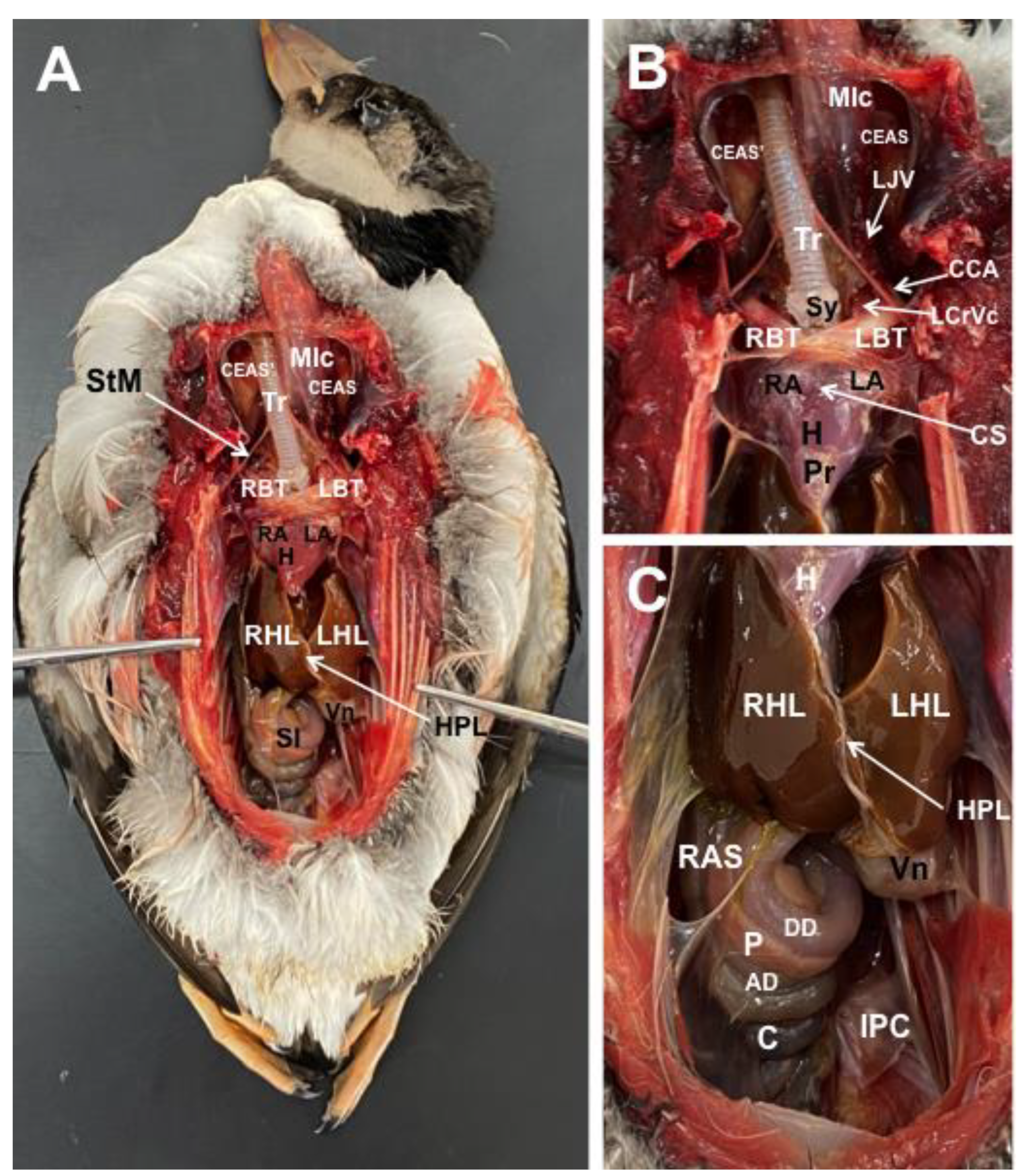
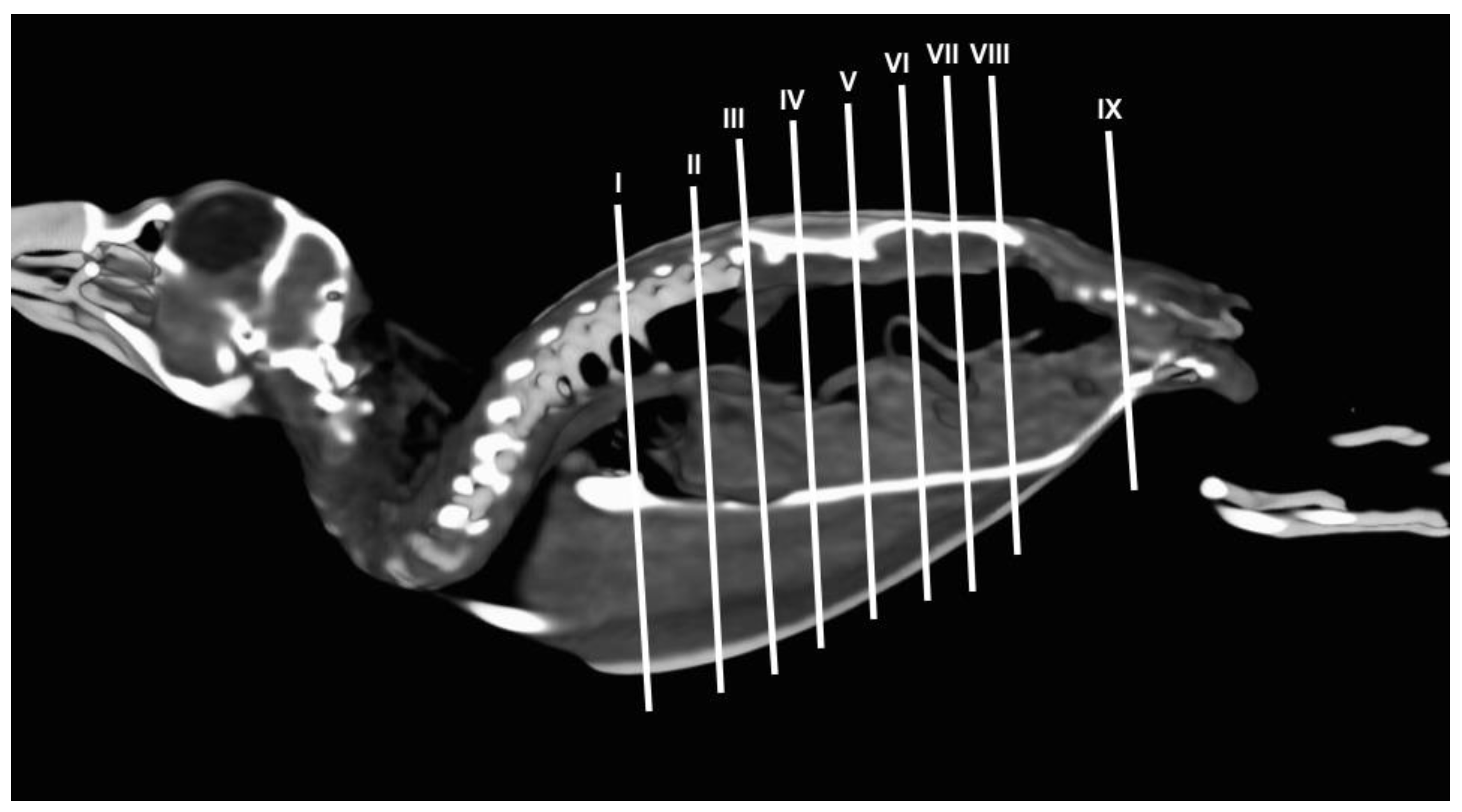
Disclaimer/Publisher’s Note: The statements, opinions and data contained in all publications are solely those of the individual author(s) and contributor(s) and not of MDPI and/or the editor(s). MDPI and/or the editor(s) disclaim responsibility for any injury to people or property resulting from any ideas, methods, instructions or products referred to in the content. |
© 2023 by the authors. Licensee MDPI, Basel, Switzerland. This article is an open access article distributed under the terms and conditions of the Creative Commons Attribution (CC BY) license (https://creativecommons.org/licenses/by/4.0/).
Share and Cite
Jaber, J.R.; Fumero-Hernández, M.; Corbera, J.A.; Morales, I.; Amador, M.; Ramírez Zarzosa, G.; Encinoso, M. Cross-Sectional Anatomy and Computed Tomography of the Coelomic Cavity in Juvenile Atlantic Puffins (Aves, Alcidae, Fratercula arctica). Animals 2023, 13, 2933. https://doi.org/10.3390/ani13182933
Jaber JR, Fumero-Hernández M, Corbera JA, Morales I, Amador M, Ramírez Zarzosa G, Encinoso M. Cross-Sectional Anatomy and Computed Tomography of the Coelomic Cavity in Juvenile Atlantic Puffins (Aves, Alcidae, Fratercula arctica). Animals. 2023; 13(18):2933. https://doi.org/10.3390/ani13182933
Chicago/Turabian StyleJaber, José Raduan, Marcos Fumero-Hernández, Juan Alberto Corbera, Inmaculada Morales, Manuel Amador, Gregorio Ramírez Zarzosa, and Mario Encinoso. 2023. "Cross-Sectional Anatomy and Computed Tomography of the Coelomic Cavity in Juvenile Atlantic Puffins (Aves, Alcidae, Fratercula arctica)" Animals 13, no. 18: 2933. https://doi.org/10.3390/ani13182933
APA StyleJaber, J. R., Fumero-Hernández, M., Corbera, J. A., Morales, I., Amador, M., Ramírez Zarzosa, G., & Encinoso, M. (2023). Cross-Sectional Anatomy and Computed Tomography of the Coelomic Cavity in Juvenile Atlantic Puffins (Aves, Alcidae, Fratercula arctica). Animals, 13(18), 2933. https://doi.org/10.3390/ani13182933







